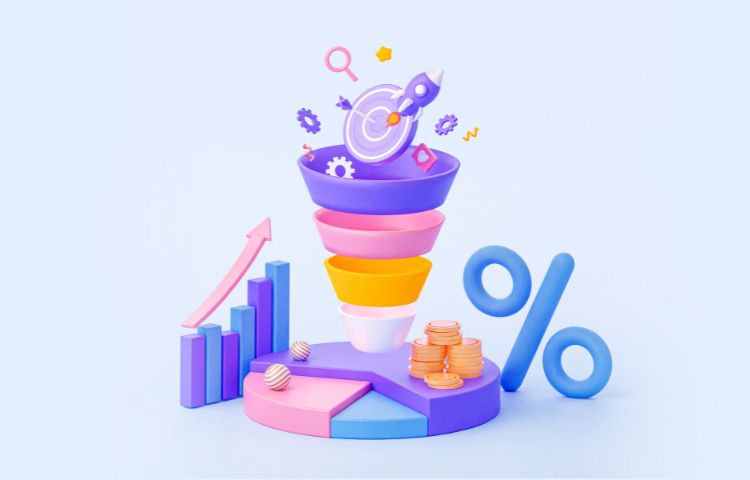

Prefer to listen instead? Here’s the podcast version of this article.
Artificial intelligence (AI) has become an increasingly popular tool in the world of marketing. It rapidly transforms various industries, and marketing is no exception. AI has the potential to revolutionize the way marketers reach and engage with their target audience, enabling them to create more personalized, effective, and efficient marketing campaigns.
In recent years, marketers have had to contend with an increasingly complex and competitive marketplace, where customers have higher expectations for personalized and relevant experiences. AI technology offers a solution by providing advanced analytics and insights, automating routine tasks, and predicting customer behavior. Let’s explore five ways AI is assisting marketers with their goals.
1. Personalization: One of the biggest benefits of AI in marketing is the ability to personalize messages and content for an individual. By analyzing user data and behavior patterns, AI can create personalized recommendations and messages more likely to resonate with the user. Personalization can lead to higher engagement rates and, ultimately, higher conversion rates. For example, Netflix uses AI algorithms to recommend movies and TV shows to their users based on their viewing history and preferences. Similarly, Amazon uses AI to recommend products to customers based on their browsing and purchasing behavior.
Algorithms can be integrated into existing systems to deliver real-time personalized content to users. For example, Quantilus achieved personalization for the second-largest chain of supermarkets in the United Kingdom by analyzing user data and behavioral patterns to identify customer segments and preferences. The supermarket faced several challenges in creating effective marketing campaigns, including needing more personalization, wasted resources, and inefficient marketing. To address these challenges, Quantilus designed and developed a segmentation and targeting model that collected data from multiple sources, segmented customers based on common characteristics, used predictive modeling to identify customer response rates and enabled the creation of targeted marketing campaigns. The model offered several benefits to the supermarket, including increased engagement, reduced waste, efficient marketing, and data-driven decisions.
2. Predictive analytics: AI can also predict future trends and behaviors based on past data. Predictive analytics can help marketers make more informed decisions regarding targeting specific audiences or creating new campaigns. Predictive analytics can also help marketers identify potential roadblocks in their campaigns before they happen, allowing them to make real-time adjustments. For example, Airbnb uses predictive analytics to forecast demand for specific properties in certain locations. Demand forecasting helps Airbnb price its listings appropriately and optimize its marketing efforts to target high-demand areas.
Organizations can customize models to meet specific business needs, such as forecasting product demand or predicting customer churn. In addition to delivering personalization for the UK supermarket chain, Quantilus also developed a predictive modeling technique that identified which customers were most likely to respond to specific promotions.
The model builds a comprehensive view of the customer base by collecting data from multiple sources, including customer transactions, demographics, and behavior. This data was then used to segment customers based on common characteristics such as demographics, purchase history, and product preferences. Finally, predictive modeling identified which customers were most likely to respond to specific promotions. As a result, the supermarket deployed targeted marketing campaigns for specific customer segments based on their characteristics and predicted response rates with a greater probability of conversion.
3. Chatbots: Chatbots are another popular application of AI in marketing. These conversational agents can answer customer questions and assist more efficiently than traditional customer service methods. Chatbots can also be used to guide customers through the purchasing process and make personalized product recommendations. For example, H&M uses a chatbot to help customers find the right size and fit for their clothing purchases. The chatbot uses natural language processing (NLP) to understand customer queries and provide helpful responses. Similarly, Bank of America uses a chatbot to help customers with their banking needs, such as transferring money or checking their account balance.
For another finance industry sector, Quantilus built an AI-based solution for a mid-market investment firm to handle many customer queries related to onboarding, cash flow, stock portfolio, notifications, news feeds, and Quantilus-developed reporting. The client faced challenges such as 24/7 availability, cost-effectiveness, and improving customer experience, which the chatbot solution addressed. The chatbot was programmed to understand the context of queries and provide accurate responses, handling complex queries by understanding their intent. Chatbots are versatile solutions that can be implemented across many industries and use cases. Explore our guide to understand what types of data can train a chatbot.
4. Image and speech recognition: AI can also analyze images and speech, providing valuable insights into consumer behavior. Image recognition can help marketers identify trends in visual content, while speech recognition can be used to analyze customer feedback and reviews. Such customer data can then be used to improve product offerings and marketing campaigns. For example, Coca-Cola used image recognition to analyze social media images and identify trends in consuming their products. Image analysis allowed Coca-Cola to create more targeted marketing campaigns that resonated with its audience. Similarly, Delta Airlines uses speech recognition to analyze customer feedback and identify areas to improve its customer experience.
Quantilus has experience in helping businesses build custom AI models that can be used to identify trends in visual content or analyze customer feedback and reviews to improve product offerings. For example, Quantilus was able to help the Sunnyvale tech startup by developing a do-it-yourself (DIY) solution that enables small and medium-sized businesses to listen, learn, and analyze across millions of social media sources. The solution uses big data for distributed storage, NLP for sentiment analysis, and indexing technology to discover and catalog sources such as blogs, news sites, and social media. The result is a single interface that allows businesses to monitor and analyze their brand’s online conversations in one place.
5. Automation: AI can automate many repetitive tasks, freeing marketers to focus on more strategic initiatives. AI can automatically send personalized emails to customers or create and schedule social media posts. Automating such tasks can save marketers time and resources, allowing them to focus on creating more impactful campaigns. For example, HubSpot uses AI to automate its email marketing campaigns. The AI algorithm analyzes user behavior and optimizes personalized emails to increase engagement and conversions. Similarly, Grammarly uses AI to automatically correct grammar and spelling errors in written content, saving writers time and improving the quality of their work.
Overall, AI is capable of automating typically intensive and time-consuming tasks. Quantilus built an AI-powered workflow that uses product metadata, images, and OpenAI to generate and update SEO-optimized product descriptions for the entire product library in the brand’s voice. Using Natural Language Generation (NLG) models, the workflow automatically generates product descriptions from structured metadata such as product name, category, features, and benefits. The NLG models were trained with brand-specific writing styles, tone, and language to ensure consistency across all product descriptions for multiple product types such as apparel, furniture, accessories, etc. Incorporating image analysis and recognition provided more accurate and descriptive product descriptions. Automating the process of creating product descriptions saves significant time and reduces the workload for content teams. Additionally, the automated product description solution provided consistent and high-quality descriptions across the platform, improved SEO optimization, and increased organic traffic from search engines.
Takeaways
The benefits of AI in marketing are vast, from providing advanced analytics and insights to automating routine tasks and predicting customer behavior. Personalization, predictive analytics, chatbots, and image and speech recognition are just a few examples of how AI is transforming the marketing landscape. As AI technology continues to evolve, businesses that embrace it will have a significant advantage over those that don’t, as they can understand their customers better and deliver more personalized experiences. With the help of AI, businesses can create more effective marketing campaigns, increase engagement, and drive revenue growth.
WEBINAR